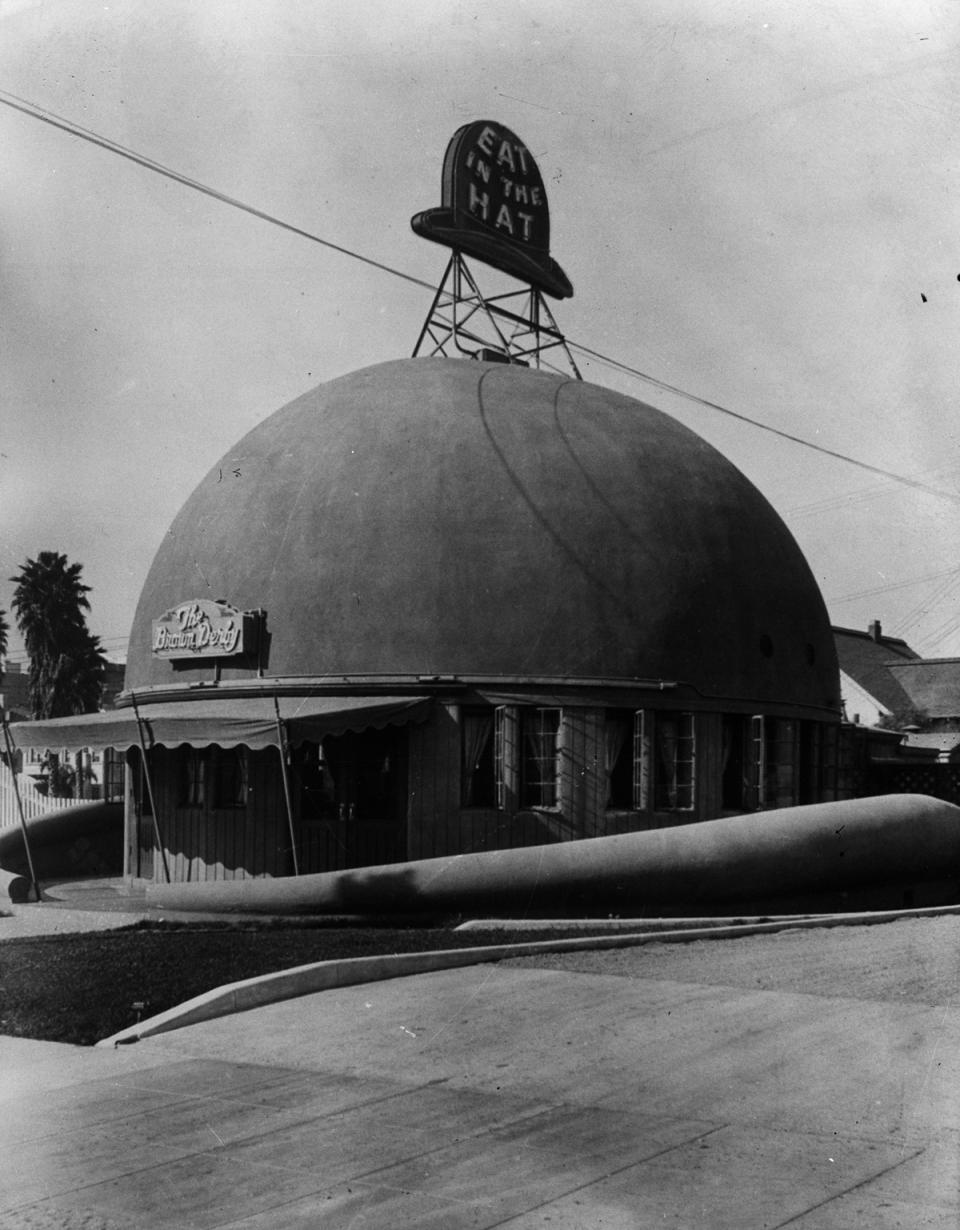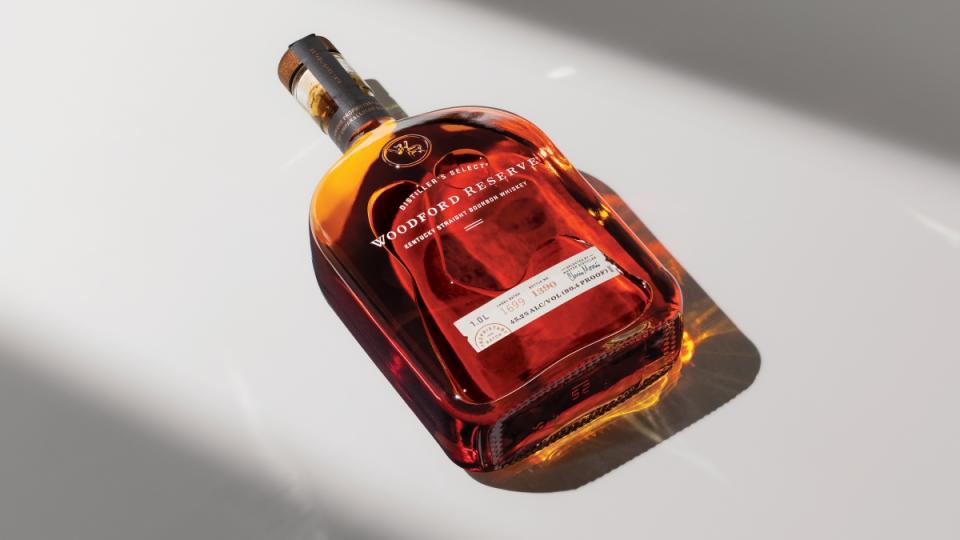How to Make a Brown Derby, the Honey-Kissed Bourbon and Grapefruit Cocktail

In 1926 in Hollywood, a man named Wilson Mizner opened a restaurant in the shape of an enormous hat.
It was an era of novelty buildings (igloos, ice cream cones, hot dogs, etc), bizarre spectacles and drew the kind of attention that bizarre spectacles would continue to draw in Los Angeles for 100 years to come. He painted it brown and called it the Brown Derby, “derby” being the American term for the English bowler hat. Atop the domed roof of the restaurant was perched a sign, itself shaped like a derby (yes, I am thrilled to report that the hat was wearing a hat) that said “Eat in the Hat,” and apparently, all of this worked so well that it quickly became one of the most popular restaurants in Hollywood.
More from Robb Report
Taste Test: Russell's Reserve's 15 Year Old is One of Wild Turkey's Best Bourbons
Old Forester Dropped a New Batch of Its Most Coveted Single-Barrel Bourbon
Woodford Reserve's Master Distiller Crafted a Bourbon With Her Dad in Time for Father's Day
Ordinarily, that would be the end of the story. The Brown Derby cocktail would be, of course, the house cocktail of the famous Brown Derby restaurant, right? Annoyingly, the answer to that question is no, and this is one of the two reasons you’ve probably never had one—if it actually had been the house cocktail of the Brown Derby, the drink would have been a lot more famous. No, the Brown Derby’s origin is more circuitous than that, essentially a game of telephone that got twisted up by a rogue greeting card writer, and deserves a brief overview.

These three ingredients—bourbon, grapefruit, and honey—show up in the Savoy Cocktail Book in 1930 under the name of the De Rigueur Cocktail. Large chunks of the Savoy are then plagiarized by a greeting card magnate named George Buzza Jr., into a strange little 1933 volume called Hollywood Cocktails, in which he changes the name of the De Rigueur to the Brown Derby, strongly implying, without evidence or reason, that this cocktail was “the favorite” served there. This wasn’t true at all—the signature drink of the Brown Derby seems to have been a brandy-based version of a Planter’s Punch—but in any event, Buzza’s book is not widely read and everyone forgets it for 70 years. Then Dale DeGroff, one of the early pioneers of our cocktail renaissance, is researching for his 2002 The New Craft of the Cocktail and comes across Buzza’s book, and has no reason to imagine anyone would just invent something like that, so he reprints the drink as the Brown Derby. Nine years later, Jim Meehan absorbs DeGroff’s assumptions and publishes the Brown Derby in the influential PDT Cocktail Book, at which point it’s as good as settled: a Brown Derby is bourbon, grapefruit juice, and honey (if you find this kind of thing interesting, the writer Robert Moss did the work to unravel all this, and writes about it in admirable detail here).
The other reason you’ve never had one is that the Brown Derby, as represented, is just barely on the wrong side of excellent. As flavors, bourbon, grapefruit, and honey work fabulously together, it’s just that their balance is a little off—grapefruit doesn’t have the acidity to make the cocktail pop all on its own, so you have to tweak it a bit to get it just right. Do that, though, and you meet a cocktail that’s an absolute banger, a study of satisfying tension: A sweet wave of honey right up front is quickly dried out with the bourbon’s oak and the grapefruit’s juicy bitterness, and the finish is lengthened by a double helix of grapefruit’s tart zest and honey’s sweet warmth, circling each other all the way out. It’s a juicy and refreshing whiskey drink, the kind that’s perfect for a father-centric Sunday in June, and good enough to be served in any restaurant, be it in the shape of a giant novelty hat or not.
Brown Derby
2 oz. bourbon
1 oz. grapefruit juice
0.25 oz. lemon juice
0.5 oz. honey syrup
1 half-dollar sized section of grapefruit peel, with as little of the pith as possible
Add all ingredients, including grapefruit peel, to a cocktail shaker with ice and shake good and hard for eight to 10 seconds. Strain off the ice into a rocks glass over fresh ice or up in a coupe (your choice), and garnish with a grapefruit peel.
NOTES ON INGREDIENTS

Bourbon: As with the marvelous Gold Rush, these flavors prefer the “sweeter” side of the bourbon spectrum (not to say they add sugar to bourbon, they don’t, just some bourbons feature sweeter flavors as opposed to spicier flavors). These would be bourbons like Buffalo Trace, Four Roses Small Batch, Woodford Reserve, or others like it. As for proof, I personally enjoyed it around 90, which allows the bourbon a full and clear voice, but I should mention that the lower proof, less expensive bourbons like Four Roses Yellow Label were great too: An 80 proof bourbon will yield a juicier and more refreshing cocktail, one that softer and therefore more suited to sunshine drinking. Your call.
Grapefruit Juice: Lots of online recipes for the Brown Derby try to advise you to differentiate between white, pink, and red grapefruit juice, which go from most bitter to most sweet, respectively. You can engage with this if you want to. If you’re not adding a bit of lemon juice, minimizing the sweetness of the grapefruit juice would indeed be important. In my experience, though, it’s difficult to find stores that carry several colors of grapefruits, and the alternative—to buy canned juice—is worse than just using fresh red or pink. Also, we’re using lemon juice to control the sweetness, so it doesn’t matter. Use whatever grapefruits you want.
Lemon Juice: The original recipe, obviously, doesn’t call for lemon, but the Brown Derby needs it. Even a weak 1:1 honey syrup (see below) and a ton of white grapefruit juice still leans sweet, especially on the finish. Grapefruit just doesn’t have the acidity to make cocktails pop. Adding a quarter ounce of lemon, however, solves that problem nicely.
I also experimented with raising the lemon juice up a bit more, but at that point we start getting into Gold Rush territory. It’s better to use a full ounce of grapefruit and then inch in the lemon, to simulate what could be just a tarter grapefruit. A Brown Derby is a juicier experience than a Gold Rush, more refreshing and less snappy.
Honey Syrup: You can’t just squeeze the honey bear into the cocktail shaker: For one, it’s too thick to measure well, and for another, when honey hits ice, it hardens like wax and doesn’t mix with anything. You have to pre-mix it with water into a syrup.
But what ratio? The world is divided on this. I’ve seen everything from 1:1 all the way up to 5.5:1 honey to water. To further complicate this, honey is 1.5x heavier than water in the same amount of volume, so wither you’re ratio is referring to measuring with weight vs. measuring with volume is very important, and less than half the recipes care to mention which one they mean.
I tried three different ratios for this drink, and my favorite—the one with persistent honey flavor but not overbearing—is a 2:1 mix (by volume) or 3:1 (by weight). So if you’re using measuring cups, it would be 3 ounces water to 6 ounces honey. If you’re using a scale, it would be 3 ounces (85g) water to 9 ounces (255g) honey.
Grapefruit Peel: I was hoping to get a great version of this drink without the supplemental grapefruit peel, but every time I made them side-by-side, the one shaken with a grapefruit peel was better. When you shake with a small piece of peel, it infuses the oils into the drink (as opposed to spraying them on top as a garnish), and the effect is to put an engine on the palate, a driving force that gives an advancing edge, like a wave, to what is otherwise a placid, pleasant, juicy experience.
I’ll say this: I love grapefruits. The above recipe is plenty good without shaking with a grapefruit peel, but for me, it’s how the drink becomes its best self. If you don’t love grapefruits, maybe you’ll disagree (also maybe this drink isn’t for you?). Take from that what you will.
Up or Rocks: This drink is traditionally served up, but there’s no reason you couldn’t serve it on the rocks. Perception of sweetness increases as a liquid warms, so if you don’t mind the last sip being a touch sweeter than the first, serve it up. If you want to keep sweetness down and don’t mind a little extra dilution in an already juicy drink, serve it on the rocks, where the ice will keep it cold but continue, slowly, to melt.
Best of Robb Report
Why a Heritage Turkey Is the Best Thanksgiving Bird—and How to Get One
The 10 Best Wines to Pair With Steak, From Cabernet to Malbec
Sign up for Robb Report's Newsletter. For the latest news, follow us on Facebook, Twitter, and Instagram.


